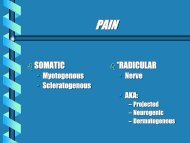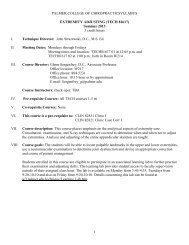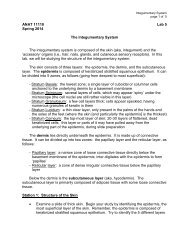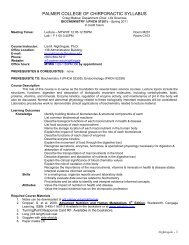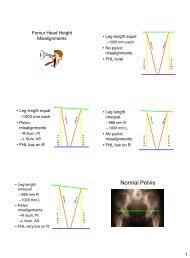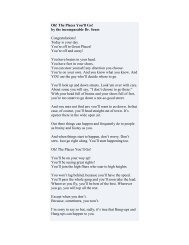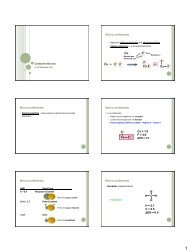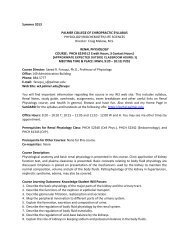You also want an ePaper? Increase the reach of your titles
YUMPU automatically turns print PDFs into web optimized ePapers that Google loves.
<strong>Thoracic</strong> <strong>Vertebrae</strong>page 1 <strong>of</strong> 6ANAT 51212 Lectures 13, 14, & 15Summer 2013I. IntroductionA. Twelve in number (on average)B. Articulate with <strong>the</strong> ribs<strong>Osteology</strong> <strong>of</strong><strong>the</strong> <strong>Thoracic</strong> <strong>Vertebrae</strong>II.Typical thoracic vertebrae (T2-T8)A. Vertebral body1. Heart-shaped in superior view2. Posterior height greater than anterior height3. Body increases in size, T3-T124. Costal demi-facets (two on each side, one superior and one inferior) forarticulation with <strong>the</strong> head (i.e., capitulum) <strong>of</strong> <strong>the</strong> riba. Superior costal demi-facet: articulates with same-numbered ribb. Inferior costal demi-facet: articulates with <strong>the</strong> next rib down5. Aortic impression (T5-T8): flattening on <strong>the</strong> left side <strong>of</strong> <strong>the</strong> vertebral bodyB. Pedicle1. Orientation: primarily posterior, with only a slight lateral angulation2. Arises from <strong>the</strong> upper third <strong>of</strong> <strong>the</strong> vertebral bodya. Superior vertebral notch/incisure: very shallowb. Inferior vertebral notch/incisure: very deep
<strong>Thoracic</strong> <strong>Vertebrae</strong>page 2 <strong>of</strong> 6C. Intervertebral foramen1. Faces directly laterally, lying within a sagittal plane <strong>of</strong> <strong>the</strong> bodya. [Upside-down] pear shape in outline2. Specific spinal nerve exiting <strong>the</strong> intervertebral foramen is identifiedaccording to <strong>the</strong> vertebra making up <strong>the</strong> superior border <strong>of</strong> <strong>the</strong>intervertebral foramenD. Lamina1. Broad superior to inferior, plate-like2. Shingling: laminae <strong>of</strong> adjacent vertebrae overlap each o<strong>the</strong>r [like shingleson a ro<strong>of</strong>]E. Vertebral foramen1. Circular in shape2. Smaller than in <strong>the</strong> cervical or lumbar regionsF. Transverse process1. Large and club-shaped, becoming shorter from T1 to T122. Oriented obliquely posterio-laterally: T2-T4 more laterally oriented, whileT5-T8 more posteriorly oriented3. Transverse tubercle contains <strong>the</strong> transverse costal facet for articulationwith <strong>the</strong> articular facet <strong>of</strong> <strong>the</strong> tubercle <strong>of</strong> <strong>the</strong> same-numbered riba. Transverse costal facet oriented anteriorly and laterallyb. In T5-T8, <strong>the</strong> transverse costal facets also face slightly superiorly aswellG. Articular processes and facets1. Superior articular facet: oriented backward, upward, and lateral (BUL)
<strong>Thoracic</strong> <strong>Vertebrae</strong>page 3 <strong>of</strong> 62. Inferior articular facet: oriented forward, medially, and downward (FMD orForMeD)3. Pars interarticularis: region between <strong>the</strong> superior and inferior articularprocesses (T1-T12)4. Distance between articular processesa. In T2-T4, <strong>the</strong> distance between superior articular processes is greaterthan <strong>the</strong> distance between <strong>the</strong> inferior articular processesb. In T5-T8, <strong>the</strong> distances are approximately equalH. Spinous process1. Long, with a distinct spinous tubercle2. Directed posteriorly and inferiorly, overlapping with <strong>the</strong> spinous processbelow, a phenomenon termed 'imbrication'a. In T2-T4, <strong>the</strong> spinous process angle from <strong>the</strong> horizontal ranges from20 o -40 ob. In T5-T8, <strong>the</strong> spinous process angle from <strong>the</strong> horizontal ranges from40 o -60 oIII. Atypical thoracic vertebrae (T1, T9, T10, T11, T12)A. T11. Vertebral bodya. Shapei. Rectangular in superior viewii.Superior epiphyseal rim slightly concave from side-to-sideb. Superior costal facet: usually a full facet, not a demi-facet
2. Pedicle: superior vertebral notch/incisure deeper than in <strong>the</strong> typicalthoracic vertebrae<strong>Thoracic</strong> <strong>Vertebrae</strong>page 4 <strong>of</strong> 63. Transverse process: laterally oriented, more horizontal and anterior than in<strong>the</strong> typical thoracic4. Spinous processa. Projecting nearly horizontallyb. Quite longi. Vertebral prominence: surface bulge at <strong>the</strong> posterior-inferioraspect <strong>of</strong> <strong>the</strong> neckB. T91. Vertebral bodya. Superior costal demi-facet may be nearly as large as a full facetb. Inferior costal demi-facet is very small or absent2. Spinous process: becoming more horizontalC. T101. Vertebral bodya. Superior costal facet may be a very large demi-facet or a full facetb. Inferior costal demi-facet is absent2. Transverse process: <strong>the</strong> transverse costal facet may be absent (<strong>the</strong> tenthrib may not form a synovial joint with <strong>the</strong> transverse process)3. Spinous process: becoming more horizontal and shorter, causing a slightdimpling <strong>of</strong> <strong>the</strong> skin overlying <strong>the</strong> spinous tubercle4. Lamina: para-articular processes are more common and more welldeveloped on T10 laminae than on o<strong>the</strong>r vertebrae
<strong>Thoracic</strong> <strong>Vertebrae</strong>page 5 <strong>of</strong> 6D. T11 (aka, anticlinal vertebra)1. Vertebral bodya. Shape: reniform (i.e., kidney-shaped) in superior view, as seen in <strong>the</strong>lumbar vertebraeb. Superior costal facet (i.e., a full facet)c. No inferior costal demi-facet2. Transverse process: short, posteriorly oriented, with no transverse costalfacet3. Spinous process: becoming lumbar-like in shape, with a nearly horizontalinferior borderE. T121. Vertebral bodya. Shape: large and reniform in superior viewb. Superior costal facet: lies partly on <strong>the</strong> vertebral body and partly on <strong>the</strong>pediclec. No inferior costal demi-facet2. Transverse process: modified into three tubercles, with no transversecostal faceta. Superior tuberclei. Large, projecting superiorly and posteriorlyii.Homologue <strong>of</strong> <strong>the</strong> lumbar mamillary processb. Lateral tuberclei. Projects laterally from <strong>the</strong> region <strong>of</strong> <strong>the</strong> lamina-pedicle junction
<strong>Thoracic</strong> <strong>Vertebrae</strong>page 6 <strong>of</strong> 6ii.Homologue <strong>of</strong> <strong>the</strong> lumbar transverse processc. Inferior tuberclei. Small, located below <strong>the</strong> superior tubercle and posterior to <strong>the</strong>lateral tubercleii.Homologue <strong>of</strong> <strong>the</strong> lumbar accessory process3. Articular process and faceta. Superior articular facet: like that <strong>of</strong> a typical thoracic vertebrab. Inferior articular facet: lumbar-likei. Faces forward, laterally, and downward (FoLD)ii.Facet surface is distinctly convex4. Spinous process: short (anterior to posterior), broad (superior to inferior),and horizontal, like those <strong>of</strong> <strong>the</strong> lumbar vertebrae ('hatchet'-shaped)



